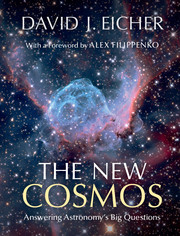Book contents
- Frontmatter
- Dedication
- Contents
- Foreword
- Preface
- Acknowledgments
- 1 The awakening of astronomy
- 2 How the Sun will die
- 3 The end of life on Earth
- 4 How the Moon formed
- 5 Where has all the water gone?
- 6 Why did Venus turn inside-out?
- 7 Is Pluto a planet?
- 8 Planets everywhere…
- 9 The Milky Way as barred spiral
- 10 Here comes Milkomeda
- 11 The Big Bang's cosmic echo
- 12 How large is the universe?
- 13 The mystery of dark matter
- 14 The bigger mystery of dark energy
- 15 Black holes are ubiquitous
- 16 What is the universe's fate?
- 17 The meaning of life in the universe
- Glossary
- Bibliography
- Index
13 - The mystery of dark matter
Published online by Cambridge University Press: 05 December 2015
- Frontmatter
- Dedication
- Contents
- Foreword
- Preface
- Acknowledgments
- 1 The awakening of astronomy
- 2 How the Sun will die
- 3 The end of life on Earth
- 4 How the Moon formed
- 5 Where has all the water gone?
- 6 Why did Venus turn inside-out?
- 7 Is Pluto a planet?
- 8 Planets everywhere…
- 9 The Milky Way as barred spiral
- 10 Here comes Milkomeda
- 11 The Big Bang's cosmic echo
- 12 How large is the universe?
- 13 The mystery of dark matter
- 14 The bigger mystery of dark energy
- 15 Black holes are ubiquitous
- 16 What is the universe's fate?
- 17 The meaning of life in the universe
- Glossary
- Bibliography
- Index
Summary
Despite the incredible advances in so many areas of astronomy over the past generation, some things remain works in progress. One of these is the mystery of dark matter, one of the fundamental components of the universe. Cosmological results in 2013 made by the Planck spacecraft team suggest the newest breakdown of the composition (mass-energy) of the universe as 4.9 percent ordinary or baryonic matter, 26.8 percent dark matter, and 68.3 percent dark energy. The story of the nearly opaque mystery of dark energy follows in the next chapter. For now, we'll explore the strange stuff that cosmologists know exists but the nature of which remains murky – dark matter.
In the early part of the twentieth century, not long after the basic cosmic distance scale and the nature of galaxies as separate “island universes” was discovered, astronomers began to stumble on clues from several directions that the bright stuff they saw in the cosmos wasn't the whole story. In 1932, Dutch astronomer Jan H. Oort (1900–1992), later to become famous for his hypothesized cloud of comets surrounding the solar system, was busily studying the motions of stars in the Sun's neighborhood. He determined that the mass of the Milky Way must amount to more than the luminous disk, the halo, and globular clusters. But a short time later, astronomers had serious doubts about the measurements.
Soon thereafter, Swiss astronomer Fritz Zwicky (1898–1974), a colorful, clever, and cantankerous fellow, took up the problem, and Zwicky was an amazing thinker and true innovator. While at the California Institute of Technology, Zwicky studied several clusters of galaxies and found that their masses must have been greater than the visible light they emitted could account for.
In a famous paper published in 1937, Zwicky suggested the possible existence of dark matter, calling it dunkle Materie, and shared the observations he had made over previous years of a variety of galaxy clusters. He didn't really push the idea, but raised it as one possible solution to the observations.
In the grand tradition of nineteenth-century science, Zwicky had become the first astronomer to widely observe and analyze a range of clusters of galaxies, cataloguing them, studying their compositions, and suggesting that some unseen material must be present to explain the orbits of the individual galaxy members, which without the unseen material would fly off into intergalactic space.
- Type
- Chapter
- Information
- The New CosmosAnswering Astronomy's Big Questions, pp. 171 - 183Publisher: Cambridge University PressPrint publication year: 2015

